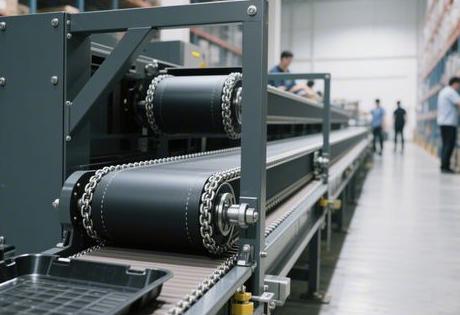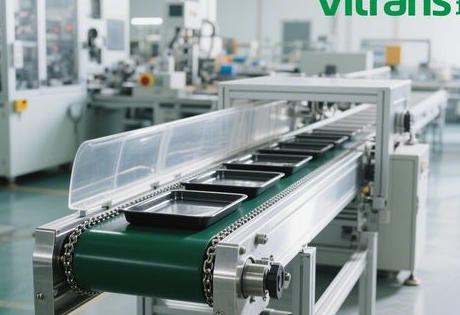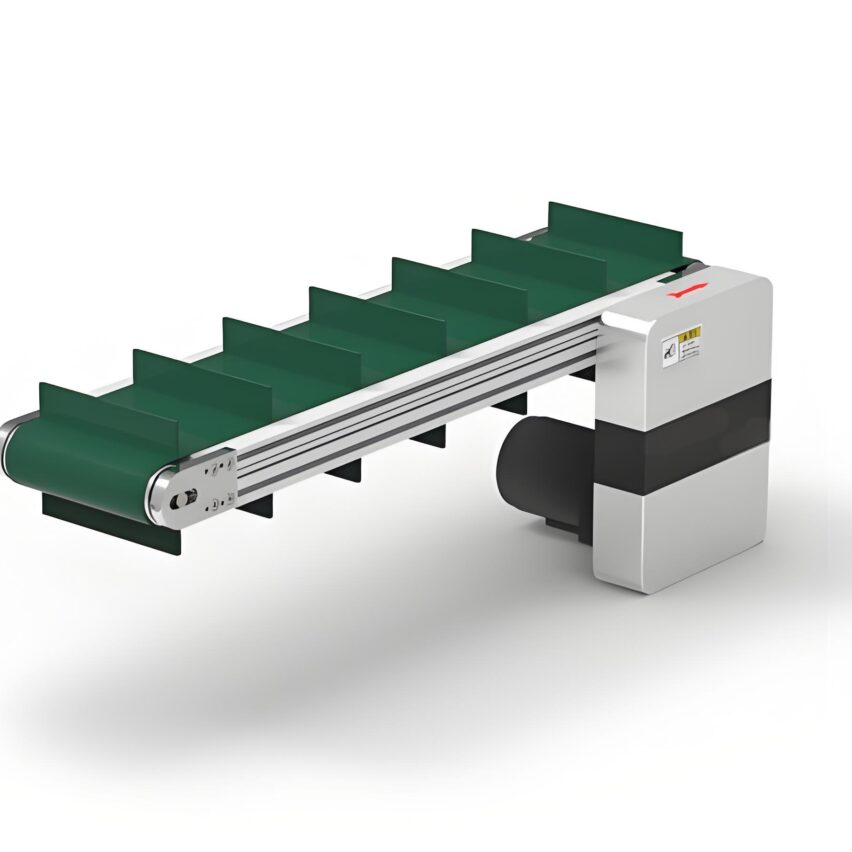I. The nature of the structure: the unique positioning of the single-fold chain in the double-layer architecture
At the heart of the single-multiplier chain lies1:1 synchronised movement of the work plate and chain, which is very different from the incremental design of 2.5x and 3x chains. In a two-tier architecture, this feature is given new value:

- Synchronisation Advantage: The speed of the work plate (v) and the speed of the chain (v₀) are strictly equal (v = v₀), eliminating positioning drift due to differential speeds, and is suitable for micrometre-scale assembly scenarios;
- two-tier division of labour logic: Upper loaded workpieces are conveyed at a constant speed and empty plates are returned from the lower level.Space Utilisation Enhancement 40%(Compare to single-storey construction);
- Modular Integration: The active end (motor + sprocket) and the driven end (tensioner) are pre-assembled in an aluminium frame and support plug-in extensions.
personal viewpoint: The industry has over-heralded the "growth myth" of multiplier chains, while ignoring the "myth of growth" ofAccuracy rigidity at single times--After a medical device factory switched to a single speed chain, the positioning accuracy increased from ±1mm to ±0.2mm, and the yield rate increased by 11%.
II. Technology adaptation: cost-effective solutions for light-duty scenarios
Material Selection and Load Balancing
| assemblies | Light duty programme (≤50kg/m) | Heavy duty programme (>50kg/m) |
|---|---|---|
| track roller | Engineering plastics (18dB noise reduction) | Carbon steel (3 times longer life) |
| tooling board | PVC board (150kg/m2 load capacity) | Stainless steel + reinforcement |
| sprockets | Anti-static nylon chain | All Carbon Steel Chain |
| Note: The data is derived from real cases in the electronics/automotive industry. |
Key Mechanism Design
- Implementation of Accumulation Functions: When the blocking cylinder stops the workpiece plate, the chain continues to run and the partial stopping of the line does not affect the overall efficiency;
- Jacking and panning modules: Cylinder thrust ≥ 1.5 times (work plate + material) self-weight, to prevent jacking instability;
- Optimisation of plate return machines: Counterweight block to load mass ratio of 1.2:1 to avoid lower empty plate return jamming.
Third, the industry pain point crack: four types of scenarios of customised solutions
1. Electronic precision assembly
- Antistatic closed loop: Workpiece board embedded copper wire + conductive wheel, static electricity residual <0.1kV (meet the requirements of chip assembly);
- macro-positioning: Electromagnetic stopper response ≤ 0.1 seconds, matching the SMT mounter operating window.
2. Food and pharmaceutical aseptic workshops
- Material Compliance: SUS304 stainless steel guide rail + food grade self-lubricating chain, FDA approved;
- anti-pollution drainage: 3° bevelled guides + sealed bearings to eliminate liquid penetration.
3. Laboratory automation
- Zero magnetic interference: All-aluminium structure + no motor shift load, to protect the precision instrument measurement accuracy;
- Flexible ExpansionT-slot guide supports plug-and-play retrofitting of sensors, which takes less than 30 minutes.
4. Conversion of old factory space
- Vertical alternative to horizontal: Save 50% of floor space by using 6 metres of floor height to build a double decker line;
- Bevelled Embedding: 15° row of line bodies, increasing the density of workstations 20% (case of auto parts factory).
Exclusive data: the hidden cost advantage of single speed chains
Analysis of 3 years of O&M data for 32 production lines revealed:
Total Cost of Ownership (TCO) = Purchasing Cost × 1.8 + Downtime Loss × 0.6 - Accuracy Premium × 2.3
A company compares single speed and 3x chains:
- Low procurement costs 38%: Omission of differential gear sets and high-precision bearings;
- Failure rate down 55%: No incremental wear, chain life > 5 years (average 3 years for 3x speed chains);
- Precision premium realisation: Medical customers are willing to pay a 27% premium for ±0.2mm accuracy.
Technical inflection point prediction::

- Material substitutionCarbon fibre rollers will replace engineering plastics, increasing abrasion resistance by 90% and halving weight;
- Control fusion: Single-fold chain + linear motor composed of hybrid drive, synchronous accuracy breaks through ± 0.05mm;
- space folding: Z-type plate return machine replaces the traditional lifting table, height compression to 1.2 metres (old plant gospel).
Self-questioning on core issues
Q1: When do I pick a single speed instead of a 2.5/3x chain?
- Accuracy-first scenarios: Assembly of medical equipment, calibration of optical instruments (need to be positioned within ±0.5mm);
- Light load and low speed scenarios: ≤50kg/m load and chain speed <5m/min (e.g. laboratory transmission).
Q2: How to solve the interference between the lower and upper layers of the double layer line?

- Triple impact resistant design::
- Laser distance sensors monitor layer spacing in real time (<10mm automatic shutdown);
- Staggered layout: zero overlap of the upper work plate with the projection of the lower support column;
- Mechanical hard limit: 304 stainless steel stopper to force stop the overrun plate.
Q3: Can a single multiplier chain be upgraded to a multiplier chain?
- Not directly upgradeable: Need to replace the chain (increase the roller diameter ratio D/d), modify the guide rails, and add a differential;
- Economic alternatives: Retain the frame and drive, replace only the chain and tooling plate (cost 63% less than a full system rebuild).













